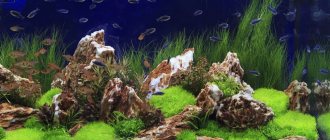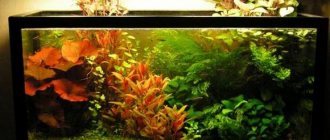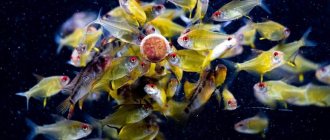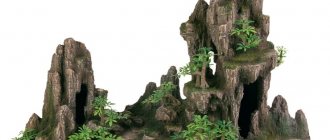The stones located at the bottom of the aquarium are a decorative element, without which the tank looks empty and unfulfilled. Pebbles require special preparation before reaching the inhabitants of the reservoir. They must be sterile and clean so as not to harm the fish, and leave the condition of the water in the aquarium the same as it was originally.
If you place dirty stones, the water will immediately become cloudy, or even worse. Even when purchasing stones in specialized stores, they must first be cleaned. To prepare stones for an aquarium, you first need to figure out which ones can be used.
What stones can be used in aquariums
A pebble from the sea, of natural origin, will do. Stones for an aquarium can also be found in small flowing rivers and lakes. Walking along the river, you must not miss a place where it is very shallow. Every stone will be at your fingertips. You can look at them and choose unique and exclusive ones.
It is correct to select pebbles with rolled, rounded edges. After all, it is precisely this feature that confirms long experience and many years of being under water.
Granite is a unique tank decorative element, especially if you intend to create a cichlid. After all, a shore strewn with pebbles is a home, a familiar habitat for cichlids. They become the place where caviar appears and fry are hatched.
Beautiful stones for aquascaping
Each aquascape, no matter how integral and harmonious it may look, consists of individual elements. And stones play the main role here. They are the bright accent around which the entire composition is built. Therefore, stones for aquascape are selected especially carefully, primarily focusing on appearance.
The following stones look good in the water:
The Dragon
It is fossilized clay in origin. The peculiarity of the stone is the holes located with an orientation in one direction. This makes the Dragon look like a rock covered in dragon scales. Most often, this stone has a greenish-brown tint and is lighter in weight compared to other natural rocks.
Porphyry
A type of granite rock of volcanic origin. It has a characteristic structure that gives it its name. Crystals of gray quartz and fawn spar with shiny edges are visible on the smooth surface. Porphyry can be reddish, greenish, brown, or purple.
Cavernous sandstone
Blocks of various shapes and sizes with through holes. The rough surface of this stone is highly decorative. You can gouge out large holes in the stone and it will look like a grotto.
Gneiss
A breed of increased hardness. Its composition is identical to that of granite, but differs in appearance by pronounced striping. Usually the stripes are gray, less often white or gray-green.
Elephant (Elephant stone)
A stone with a very textured surface of gray or brownish color. It looks like the wrinkled skin of an elephant, which gives the stone its name.
Carpathian stone
One of the best options for creating natural style compositions. It has natural shades and practically does not affect water parameters.
Gray Mountain (Gray Mountain)
Its name speaks for itself. The texture and color of this stone imitates natural rocks. This option is indispensable for compositions in the Iwagumi style.
Gabbro diabase
A completely crystalline volcanic rock with a dark gray or greenish-black color. Looks good in glued compositions.
Slate
A hard rock with a layered structure. Color ranges from light gray to almost black. Brightly colored stripes are visible on the side faces.
Mesh stone
The porous structure is highly decorative and at the same time serves as a natural biofilter.
Samurai
A black stone of varying saturation with a porous surface.
A wide selection of stones and ready-made compositions for aquascapes is offered by a specialized manufacturer of equipment for aquariums, ADA. In online stores you can purchase both individual stones of interesting texture from this company (natural and artificial) and ready-made sets for aquascape.
How to prepare and disinfect rocks before filling the bottom of the aquarium?
- Go through everything you've collected. There may be excess debris.
- Find a container in which the pebbles will lie in one layer. Fill with plain water. This must be done to remove accumulated salts.
- In order for the flints used in the future to be 100% cleaned, they need to be boiled.
During the boiling process, all salts will dissolve, you will achieve complete disinfection. You can also check the quality of stones purchased in specialized stores. If you buy bright, colorful pebbles, there is a chance that they are painted. By playing it safe (by boiling it first), you will find out the true quality and authenticity of the purchased product.
Understand that this procedure is necessary if you want to see the aquarium clean and well-groomed, and the inhabitants healthy.
How to remove green deposits on the walls of an aquarium
A dense layer of green deposits in the aquarium impairs visibility.
The cause of contamination is microscopic algae - Protococcus. As a result of their growth and development, a greenish layer of cells is formed on the inside of the walls. If it is small, this is normal and will not harm the fish in any way. But if the plaque becomes so abundant that it is impossible to see through it what is in the aquarium, it’s time to take action.
Getting rid of green algae is simple: you need to wait until Protococcus completes the process of asexual reproduction by zoospores. The cycle lasts 3 weeks. During this period, all zoospores should settle on the walls and become full-fledged cells. As a result, the unpleasant green coating will gradually lighten and die off.
After 21 days, you can clean the glass using a scraper. It is easy to get rid of the remains of dead cells with a hose equipped with a water change system.
To ensure that the situation does not repeat itself, it is necessary to analyze the reasons why Protococcus appeared and make efforts to eliminate them. Most often, green deposits appear in containers that are placed in direct sunlight. High water pH also promotes algae growth. Eliminate these causes, and plaque formation will remain within normal limits.
If you clean the glass before the end of its life cycle, it will take months to scrub off the green mass on the walls of the aquarium.
How long should you boil aquarium stones brought from the sea?
There is no difference between boiling river, lake and sea boulders. It's a matter of soaking. If ordinary granite was soaked once, and then immediately boiled. This number won't work here. Sea flints are soaked 4-5 times as they contain more salt. Don't forget this. The first time, leave the stones to “soak” overnight, then change the water during the day. Boil in the evening, then dry. And the very next morning you can improve the aquarium.
With truthful information about how to treat aquarium rocks and what kind of rocks you need to select, you will be two steps ahead. You can prevent:
- plant death;
- illness and death of fish;
- water bloom;
- the appearance of an unpleasant odor from the aquarium;
- cloudiness and contamination of water.
By choosing decent pre-care, you will ensure the comfort of underwater inhabitants. Treated flints will not harm the fish or anything in the tank.
Owners of ponds claim that live rocks for an aquarium are an element necessary for the life of fish. They are used by experienced tank owners.
How to remove brown plaque on walls
Brown coating on walls and plants appears due to diatoms.
Brown coating may appear due to the development of diatoms. If it is discovered during the start-up of the aquarium and has not yet spread to the entire area, you can get rid of it by maintaining proper maintenance. In this case, they will disappear within two weeks. It is recommended to regularly clean the glass and change up to 30% of the water. With this approach, intensive development of plants will displace diatoms.
If the appearance of diatoms is detected in an existing aquarium, you should change the liquid more often, adding about a quarter of fresh water 2-3 times a week. It is also necessary to clean glass and interior decorative elements using brushes, scrapers, and sponges.
In addition, you should pay attention to the filter. For example, the filtration rate may decrease due to air pollution or contamination of the water intake system. It is also worth reducing the daylight hours to 360 minutes per day, then increasing its duration to 10 hours over 14 days. Lamps need to be changed once a year.
Residents such as Otocinclus, Theodoxus snail, Siamese algae eater, Hypostomus plecostomus, Gyrinocheilus and mollusks will also help get rid of brown algae.
Controlling diatoms with chemicals is in most cases ineffective and can worsen the situation. Using a preventative dose of algaecides will stimulate the growth of aquarium plants, which will help get rid of the problem.
Live rocks for the aquarium: advantages, disadvantages
Imagine a real sea reef. A beautiful, bright picture immediately appeared before my eyes. That's right. The reefs are beautiful. So, everything that breaks off from the reef is living granite.
In appearance, the reef fragment resembles a sponge. And inside there is a living world filled with all kinds of microorganisms. Hence the name - “living”. If you come across a piece of a reef in which live corals live, you can be sure that the aquarium will begin to “breathe deeply.”
Bacteria living in pieces of reefs will perfectly cope with the primary tasks of the filter. Simply put, they turn the remains of dry food and feces into nitrogen gas, which dissolves after some time. This process is called the nitrogen cycle. The number of such reef fragments determines whether they will be able to clean the entire aquarium.
Advantages:
- A “living” filter for an aquarium that purifies water.
- The variety of shapes and sizes will provide fish with places to hide, play, and lay eggs.
- An exclusive decorative element. Both the reef itself and the algae growing from it. The color of algae is purple and pink.
- Natural, natural look of the tank.
- Pisces will begin to feel at home.
How to post
- You can't just throw stones on the bottom . It is important to arrange them beautifully, creating a certain composition. Nature is diverse and natural, but this does not mean that there is no order in it. The construction of a stone skeleton is subject to certain rules of beauty and safety.
- One of the most common mistakes that beginners make when placing heavy decorations in an aquarium is placing them against the walls. Under strong pressure, the glass will crack. Most aquarium materials are durable, but can break easily under added pressure.
- Avoid placing rocks in one part of the aquarium . It's better to spread them out evenly. But if the intended design does not fit into the recommendations, then you need to make sure that the glass can withstand the additional weight.
- Ensure the durability of the composition . Otherwise, a fast school of fish may knock over a pebble, which, depending on its size and weight, may result in a crack in the glass. But even if the glass stands, the stone can crush one of the inhabitants of the aquarium. You can strengthen the composition with special aquarium silicone glue. Most pet stores offer safe products, but it doesn't hurt to double check.
As for style, there are several composition options:
Iwagumi
This Japanese style is preferred by aquascape guru Takeshi Amano in his compositions. It is based on the use of 1 – 2 large stones of outstanding height in the center of the composition, framed by several small specimens and one type of low-growing plants.
Hardscape
Translated, the word means Hard - hard, heavy and Scape - landscape. The design is characterized by heaviness and heaviness. The bottom is completely filled with heavy stones and driftwood. This design is preferable for cichlids.
Dutch style
Stones in this version serve as an imitation of garden paths. Therefore, small specimens are placed on the bottom. This herbal aquarium resembles a flowerbed.
Pseudo-natural style
Shell rock, large pebbles and granite will fit well into this composition. Natural stones in this version are combined with glass and plastic.
Natural style
A union of stone and wood, or rather oddly shaped driftwood. The designer's task is to recreate the appearance of a natural reservoir.
Don't turn your aquarium into a mineral museum. It is better if it contains specimens of the same texture and similar in color. Then at the bottom of the reservoir you will get a natural, harmonious composition.
Preparing rocks for an aquarium
Living flints are processed for 3–4 weeks before being sent to the owner. Sometimes, more than two months. This must be done in stores before putting the product up for sale.
How to clean living stones should not be a question for you. If a small dead portion is noticed, remove immediately.
Aquarium stones are not a simple matter and require special care. By paying attention to the stones and disinfecting them in a timely manner, the fish will say “thank you.” Stones are the key to cleanliness and order in the sea world. Don't leave them aside. Boiling is a process that must be carried out at least once a month.
What is needed for cleaning?
Having eliminated all the causes of plaque, it is necessary to properly clean the ecosystem of algae. How to clean and what to wash the aquarium with? Cleaning an aquarium at home requires the availability of special equipment, which can be purchased at any place where aquarium fish are sold.
Cleaning the aquarium from green deposits using a soft brush
To clean the aquarium you will need:
- a scraper to remove algae from glass;
- water container, volume from 10 l;
- prepared replacement water in sufficient quantity;
- filter accessories;
- siphon type pump;
- aquarium glass cleaner;
- baking soda or wine vinegar to clean the aquarium;
- 10% bleach solution;
- blade.
Treatment
It is advisable to carry out the processing even if you purchased them in a store.
This is a fairly simple and effective way to prepare rocks for your aquarium so that no problems arise in the future. It is necessary to boil or heat the stone in the oven, since a brush will not be able to wash off all microorganisms.
Where to get stones
The easiest way to purchase stones is to go to a pet store and buy minerals there. This is not only quick and easy, but also safe as there is little risk of getting a toxic or unsuitable breed for your aquarium. However, such pebbles, as a rule, are already processed and prepared for being in the tank, and therefore are relatively expensive. For this reason, aquarists often try to find stones on their own.
There are many options for finding stones for an aquarium, for example, on the street, in the forest, near a river or the sea. However, before you rush to pick up every stone, it is worth knowing which stones to choose. After all, if the “wrong”, in other words, harmful stone gets into the aquarium, the result of such proximity to fish can be disastrous.
Basic design options for stone compositions
Not everyone, even an experienced aquarist, let alone beginners, knows how to decorate an aquarium with fish with a stone composition. After all, the design of the tank should be unobtrusive, beautiful and stylistically correct. But for this it is not at all necessary to invent something masterly and unique on your own; you can create a composition in one of the styles that are popular at the present time.
- Decoration in Dutch style. It resembles a full-fledged flowerbed with green, red and other plants, only located under water. In such an aquarium there are many green plants, but they are all sorted by size, color and height, have their own clearly defined place, and therefore do not creep into “foreign” territory. In this case, the role of pebbles, namely pebbles and shell rock, will be to imitate paths between flower beds.
- Stone composition in Japanese style. Here, too, there is an imitation of terrestrial living vegetation, but of a different kind. In this style, the stones will not be used as a substrate, but as iwagumi - a typical stone composition of Japanese gardens. In this case, excessive decorations are not appropriate, since minimalism is welcomed in the design. In order to achieve picturesqueness, cobblestones are selected in different sizes.
- Decorating an aquarium with stones in a pseudo-natural style. An excellent option for those people who do not want to spend a lot of effort on decorating both a large and small aquarium. This style is characterized by a minimum of effort and money costs, and therefore has a fairly simple appearance. Granite, shell rock and pebbles will fit well into such an atmosphere.
- Decorating an aquarium in a natural style. This style is rightfully considered one of the most difficult to reproduce, so only experienced aquarists resort to it. The purpose of this design is to recreate as accurately as possible a certain section of the bottom of the reservoir in the aquarium.
Kinds
Let's first figure out what types of aquarium stones are divided into. They can be divided into 2 main groups and have their own subspecies:
- Artificial
- Natural (natural) origin
- Natural origin
- Processed
Artificial ones can be purchased at a pet store. They are made from safe and non-toxic plastics. The choice ranges from cheap multi-colored glass pebbles to more expensive ones that look more like real ones.
Processed ones are also sold in pet stores, usually in the form of compositions in the form of caves, rocks, grottoes. One of the disadvantages is that to create such compositions you need to glue the stones (but ordinary glue can negatively affect the environment) and paint, and also often use fragile material. The better the processing, the higher the price.
Stones of natural origin are most often found among experienced aquarists. Before placing them in the aquarium, careful processing is necessary. You can take stones directly from nature. Of course, the big plus is that they are taken directly from the natural environment, thus feeling great in the aquarium and not causing harm to the inhabitants.










